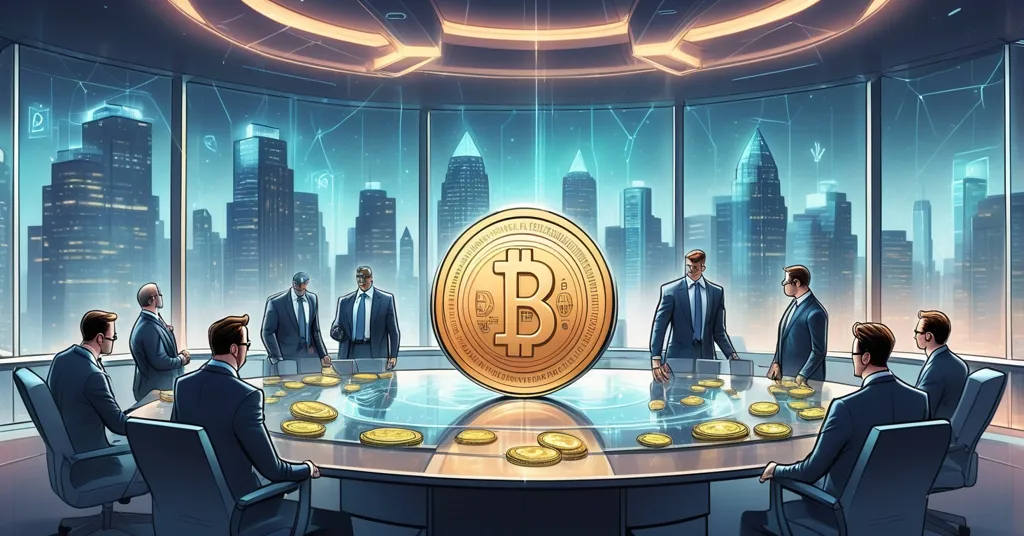Public Companies Stack XRP in Reserves: A Bold Shift in Corporate Finance

Public Companies Are Stacking XRP in Their Reserves: A Game-Changing Trend
Public companies are making a bold move by adding XRP to their treasury reserves, joining the ranks of Bitcoin and Ethereum as viable corporate assets. Crypto lawyer Bill Morgan has uncovered this shift through recent SEC filings, noting XRP’s appeal for its lightning-fast transactions, rock-bottom fees, and unparalleled cross-border payment capabilities.
- Corporate Adoption: More public companies are holding XRP, lured by its speed and cost efficiency.
- Legal Boost: Ripple’s victory over the SEC has cleared the path for confident XRP investments.
- Market Wildcard: Ripple Labs’ 40.7 billion XRP stash could reshape supply and price dynamics.
The crypto market isn’t just for speculators anymore—it’s becoming a cornerstone of corporate finance. Once content to park funds in Bitcoin as a hedge against inflation, public companies are now diversifying into altcoins like XRP. Why? Simple: XRP settles transactions in 3-5 seconds with fees under $0.0002, blowing traditional systems like SWIFT—and even Bitcoin’s slower, pricier transfers—out of the water. For firms dealing with global payments or liquidity management, this is a no-brainer. RippleNet, the network powering XRP, connects financial institutions worldwide for near-instant transfers, making it a practical tool for real-world business needs, not just a shiny token to HODL.
Bill Morgan, a crypto lawyer with a knack for digging through regulatory paperwork, recently spotted a surge in XRP adoption. In a single week, he identified multiple firms adding it to their balance sheets, calling it a clear sign of growing corporate trust as reported in recent updates. Let’s break down some key players. Quantum Biopharma Ltd, previously invested in Bitcoin, Dogecoin, and Solana, has scooped up XRP and Ethereum to round out its portfolio. Worksport Ltd, meanwhile, holds both Bitcoin and XRP, having doubled its Bitcoin holdings recently and boasting a 15% gain on XRP since adopting a crypto strategy in late 2023 as a shield against currency devaluation. Then you’ve got heavy hitters like Trident Digital Tech Holdings, reportedly planning a staggering $500M XRP investment, and Nature’s Miracle Holding Inc., allocating up to $20M. Other names—Flora Growth Corp, Hyperscale Data Inc., Wellgistics Health, and VivoPower International PLC—span industries from biopharma to tech to healthcare, proving XRP’s appeal isn’t limited to finance nerds. For more on Quantum Biopharma and Worksport’s strategies, check their financial reports.
Corporate leaders aren’t shy about their reasoning. Zeeshan Saeed, CEO of Quantum Biopharma, put it bluntly:
Cryptocurrencies are a shield against the dollar’s erosion and a source of unrealized profits.
Similarly, Milton “Todd” Ault III of Hyperscale Data sees XRP as central to their pivot into AI and data center tech, hinting at deeper blockchain integration beyond mere holdings. These aren’t random gambles; they’re strategic plays by diverse sectors to leverage XRP’s strengths.
Why XRP? Unpacking the Appeal
For those new to the space, XRP is a digital currency tied to Ripple Labs, designed specifically for fast, cheap global payments—unlike Bitcoin, which acts more as a store of value, or “digital gold.” Where Bitcoin transactions can take minutes (or hours during congestion) and cost dollars in fees, XRP zips through in seconds for pennies. This makes it ideal for companies needing to move money across borders without the delays or expense of traditional banking rails. RippleNet amplifies this by linking banks and payment providers globally, creating a seamless network for transactions—think of it as a turbocharged alternative to outdated systems. Learn more about the benefits of using XRP for cross-border payments.
Beyond raw utility, a major driver of this trend is legal clarity. For years, the Ripple vs. SEC lawsuit hung over XRP like a dark cloud, with questions about whether it’d be deemed a security and hit with crippling regulations. But rulings in 2023 and 2024, coupled with legislative pushes like the CLARITY Act and GENIUS Act—potentially classifying XRP as a digital commodity—have lifted that fog. Companies no longer fear waking up to regulatory whiplash, making boardroom decisions to stack XRP a lot less sweaty. This timing couldn’t be better, as corporate investment in altcoins (outside Ethereum) has reportedly ballooned from $200 million to over $11 billion in a short span, though exact figures and timelines remain murky and should be taken with a grain of salt until verified. Curious about the motivations behind these investments? Explore some perspectives on why companies are betting on XRP.
Ripple’s Massive Stash: Boon or Bane?
Here’s where things get spicy: Ripple Labs itself holds a colossal 40.7 billion XRP—about 41% of the total supply. That’s enough to make even a Bitcoin whale break a sweat. If Ripple treats this hoard like a treasury reserve, akin to MicroStrategy’s Bitcoin strategy, it could slash circulating supply and push prices skyward. It’s a vote of confidence that might lure more institutions to the table. But flip the coin, and you’ve got a centralization nightmare. Crypto purists, myself included as a Bitcoin maximalist at heart, cringe at one entity wielding so much control. Are we swapping one centralized system (banks) for another (Ripple’s dominance)? It’s a bitter pill to swallow. How Ripple manages this stash—whether they HODL like a dragon or dump to fund operations—will be a defining plotline in XRP’s corporate saga. For a deeper dive into this, see the analysis on Ripple’s holdings and market influence.
Beyond Hoarding: How Firms Are Using XRP
Think XRP is just a shiny coin to sit on? Think again—companies are putting it to work. Unlike Bitcoin, often parked as a static asset, XRP’s design lets firms get creative. One avenue is institutional lending, where they loan XRP to other entities for interest, much like a bank but on blockchain terms. Another is providing liquidity on exchanges, helping trades flow smoothly and earning small fees in return. Then there’s integration with platforms like Flare, a blockchain that acts as a bridge, letting XRP interact with smart contracts despite the XRP Ledger lacking native staking. Through Flare’s FAssets system, firms like VivoPower can “wrap” XRP for use in decentralized finance (DeFi), unlocking ways to generate yield. Wellgistics Health, on the other hand, uses it for real-time programmable payments. This versatility is XRP’s ace, setting it apart from Bitcoin’s “sit and appreciate” vibe or Ethereum’s gas-fee headaches for small transactions.
Risks and Reality Checks: No Rose-Colored Glasses Here
Before we get too cozy with the hype, let’s slam the brakes. This corporate XRP wave isn’t all smooth sailing—there are potholes aplenty. Ripple’s massive holdings spark fears of market manipulation; a sudden dump could tank prices faster than you can say “bear market.” Volatility is another beast—XRP’s history of wild swings means that 15% gain Worksport bragged about could flip into a gut punch overnight. Just look at past crashes: XRP dropped over 60% in a matter of weeks during the 2018 bear run. Transparency’s a mess too—Bill Morgan himself flagged that some SEC filings mislabel XRP as “Ripple,” screwing up public data. If companies can’t even report holdings right, what else are they botching? Sloppy paperwork is a red flag, plain and simple. For further insights into corporate strategies and Ripple’s influence, explore discussions on XRP’s corporate adoption.
Regulatory risks haven’t vanished either. Sure, the U.S. offers some clarity now, but crypto policy here is a political football—one election could flip the script. Globally, it’s even messier. Europe’s MiCA framework and Asia’s patchwork rules could snag XRP’s corporate uptake if they diverge from U.S. stances. And let’s be real: XRP isn’t dethroning Bitcoin as the store-of-value king or Ethereum as the DeFi titan. It’s carving a niche in payments, but it’s not a cure-all. Stellar (XLM), another payment-focused token, competes in the same lane, though XRP’s edge lies in Ripple’s established banking ties. Still, as a Bitcoin maximalist, I’ll say it loud—BTC remains the unshakeable rock of value. XRP’s just handling the quick-and-dirty transfers, and that’s okay. For a broader look at companies under Ripple’s influence, check out this analysis of XRP as a reserve asset.
Market Implications: Ripple Effect or Ripple Tsunami?
This corporate pivot to XRP isn’t just a footnote—it could ripple through the broader market. Retail investors might take notice, seeing boardroom bets as a green light to jump in, potentially fueling demand. More crucially, it could drive partnerships between RippleNet and traditional finance giants, embedding XRP deeper into global payment systems. Imagine SWIFT on steroids, powered by blockchain. But there’s a flip side: if too many firms stack XRP purely for speculation rather than utility, we risk another bubble. And if Ripple’s stash becomes a centralization bogeyman, it might scare off the very decentralization advocates who birthed crypto. Adoption matters more than moonshot fantasies, so let’s ditch the “XRP to $10,000” nonsense peddled by shillers. Real progress is in utility, not price pumps.
What’s Next for XRP in Corporate Finance?
Peering into the crystal ball, a few scenarios loom. On the bullish side, more RippleNet integrations with banks could cement XRP as the go-to for cross-border settlements, pulling in even bigger corporate players. Platforms like Flare might unlock new DeFi use cases, turning XRP from a payment token into a multifaceted asset. But the bearish case stings—if Ripple dumps chunks of its stash, or if regulatory winds shift globally, this corporate love affair could sour fast. Then there’s the decentralization question: will firms using XRP push for more distributed control, or cozy up to Ripple’s influence? As champions of freedom and disruption, we should cheer any tech that dismantles creaky financial systems—but only if it doesn’t trade one master for another.
Key Takeaways and Questions on XRP’s Corporate Surge
- What’s driving public companies to stack XRP in their reserves?
XRP’s rapid 3-5 second settlements and fees under $0.0002 per transaction make it perfect for cross-border payments and liquidity needs, outpacing Bitcoin’s slower, costlier model. - How has the Ripple vs. SEC lawsuit resolution shifted the landscape?
Legal clarity from 2023-2024 rulings has erased regulatory fears, letting firms like Quantum Biopharma and Worksport invest in XRP without dreading SEC crackdowns. - What could Ripple Labs’ 40.7 billion XRP holdings mean for the market?
Holding 41% of supply, Ripple could spike prices by limiting circulation if treated as a reserve, though it fuels centralization worries among decentralization diehards. - How are companies turning XRP into income?
Firms leverage institutional lending, provide exchange liquidity, and use platforms like Flare for smart contract integration, making XRP a revenue-generating asset beyond mere holding. - Why branch into XRP when Bitcoin dominates as a safe haven?
Bitcoin’s a store of value, but XRP’s strength in fast, cheap transactions offers a different risk profile, letting companies tackle practical payment challenges while hedging inflation.
Corporate adoption of XRP screams one thing: blockchain is rewriting the rules of finance from the ground up. It’s not about crowning a single winner—Bitcoin, XRP, Ethereum each bring unique firepower to disrupt the status quo. As advocates of decentralization and privacy, we should celebrate this push against rusty traditional systems, rough edges and all. Companies betting on XRP aren’t just speculating; they’re laying bricks for a faster, freer financial future. But stay sharp—if Ripple or these firms play their cards wrong, this revolution could stumble. Keep your eyes peeled; the story’s just heating up.



